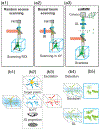Scanless volumetric imaging by selective access multifocal multiphoton microscopy
- PMID: 31984218
- PMCID: PMC6980307
- DOI: 10.1364/optica.6.000076
Scanless volumetric imaging by selective access multifocal multiphoton microscopy
Abstract
Simultaneous, high-resolution imaging across a large number of synaptic and dendritic sites is critical for understanding how neurons receive and integrate signals. Yet, functional imaging that targets a large number of submicrometer-sized synaptic and dendritic locations poses significant technical challenges. We demonstrate a new parallelized approach to address such questions, increasing the signal-to-noise ratio by an order of magnitude compared to previous approaches. This selective access multifocal multiphoton microscopy uses a spatial light modulator to generate multifocal excitation in three dimensions (3D) and a Gaussian-Laguerre phase plate to simultaneously detect fluorescence from these spots throughout the volume. We test the performance of this system by simultaneously recording Ca2+ dynamics from cultured neurons at 98-118 locations distributed throughout a 3D volume. This is the first demonstration of 3D imaging in a "single shot" and permits synchronized monitoring of signal propagation across multiple different dendrites.
Figures




References
-
- Stuart GJ and Spruston N, “Dendritic integration: 60 years of progress,” Nat. Neurosci 18, 1713–1721 (2015). - PubMed
-
- Rall W, “Core conductor theory and cable properties of neurons,” in Comprehensive Physiology (Wiley, 2011).
-
- Benavides-Piccione R, Hamzei-Sichani F, Ballesteros-Yáñez I, DeFelipe J, and Yuste R, “Dendritic size of pyramidal neurons differs among mouse cortical regions,” Cereb. Cortex 16, 990–1001 (2006). - PubMed
-
- DeFelipe J and Fariñas I, “The pyramidal neuron of the cerebral cortex: morphological and chemical characteristics of the synaptic inputs,” Prog. Neurobiol 39, 563–607 (1992). - PubMed
Grants and funding
LinkOut - more resources
Full Text Sources
Other Literature Sources
Miscellaneous
